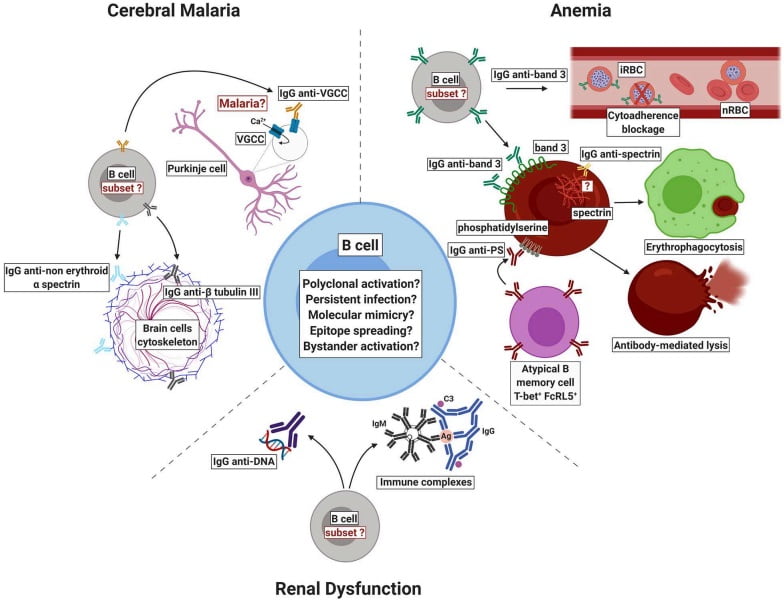NAA Associated Malaria
With the continuous expansion of the medical research field, the association between various infections and the presence of natural autoantibodies (NAA) has generated interest for a long time. Detection of NAA is routinely performed for the diagnosis of systemic autoimmune and infectious diseases. Nowadays, Creative Biolabs is currently offering high quality, highly comprehensive NAA services for malaria to fit your research demands.
Introduction of Malaria
Malaria, a parasite infection of red blood cells (RBC), is endemic in almost 100 countries and it is the most prevalent vector transmitted disease worldwide. More than 2.2 billion people are exposed every year to Plasmodium falciparum (P falciparum) infection, among whom 500 million experience clinical attacks with potential evolution toward lethal disease. The pathology of malaria is associated with the blood stage of infection as shown in Fig.1. P falciparum infections have high multiplication rates with expressing clonally variant antigens at the surface of infected erythrocytes (Pf-EMP-1). Pf-EMP-1 binds to ligands on the surface of endothelial cells and mediates sequestration of infected erythrocytes in postcapillary venules. These characteristics allow the P falciparum parasite to evade the host immune system, resulting in the occurrence of high parasitemias with repeated infections that contribute to the chronic nature of this disease.
There are several clinical forms of malaria such as chronic carriage, gestational malaria and hyper-reactive malarial splenomegaly (HMS). The spectrum of the clinical presentation and severity of P falciparum infection is broad, ranging from uncomplicated febrile illness to coma, respiratory distress, hypoglycemia, and a high frequency of concurrent bacteremia. Additionally, severe anemia may be accompanied by other syndromes of severe diseases, such as malaise, fatigue, dyspnoea, or respiratory distress as metabolic acidosis supervenes.
Natural Autoantibodies in Malaria
Antigen non-specific immunological derangements in malarial infections are well known for immunosuppression and autoantibody formation. Titers of autoantibodies correlate with titers of anti-malarial antibodies. In human, there is a high incidence of hypergammaglobulinaemia and autoantibodies in natives of endemic areas of malaria. Conventional parasitological tests are often negative or not performed. Extensive explorations of these conditions often include the search for natural autoantibodies against different targets. Here show several targets in malaria that could be utilized to offer NAA-related services.
 Fig.1 Self-reactive antibodies and their proposed role in malaria pathogenesis or prevention.1
Fig.1 Self-reactive antibodies and their proposed role in malaria pathogenesis or prevention.1
| Natural Autoantibodies Targets in Malaria | ||
| Fluorescent Anti-Nuclear Antibodies (FANA) | Anti-Smooth Muscle Antibodies (SMA) | Anti-Nuclear Antibody (ANA) |
| Anti-dsDNA | Anti-Rheumatoid Factor (RF) | Anti-Mitochondrial Antibodies (AMA) |
Acute malarial infection is especially associated with high incidence of autoantibodies to nuclear and smooth muscle antigens. Many efforts have been made to make progress in this regard. For instance, malaria-related fluorescence pattern on the antinuclear autoantibodies (ANA) test is highly suggestive for the diagnosis and triggers immediate, easy confirmation and adapted therapy.
Features of our Technologies
- A series of molecular biotechnologies: ELISA/WB/Dot Blot/LIPS
- Comprehensive NAA technology platform: Protein Array/Peptide Array
- Multiple Affinity Protein Profiling (MAPPing)
- Low cost
- Best after-sale services
Natural autoantibodies may be used as early biomarkers for diseases detection and prevention. Creative Biolabs has developed and utilized several high-throughput technologies in the discovery and detection of autoantibodies. With expertise and dedication, Creative Biolabs will be your best companion in NAA-related services. Please do not hesitate to contact us for more information and a detailed quote.
Reference
- Mourão, Luiza Carvalho, Gustavo Pereira Cardoso-Oliveira, and Érika Martins Braga. "Autoantibodies and malaria: where we stand? Insights into pathogenesis and protection." Frontiers in Cellular and Infection Microbiology 10 (2020): 262.
Choosing natural autoantibody (NAA) microarray to profile autoantibody repertoire and reveal novel disease's marker.
- NAA Services for Fluorescent Anti-Nuclear Antibodies (FANA)
- NAA Services for Anti-Smooth Muscle Antibodies (SMA)

